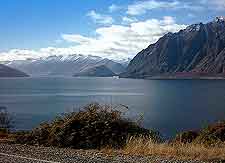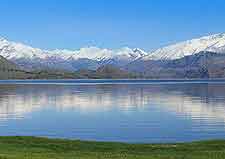Wanaka History Facts and Timeline
(Wanaka, Otago, South Island, New Zealand)

The small town of Wanaka, in the centre of New Zealand's South Island, stands on the edge of Lake Wanaka and at the southern end of the Mount Aspiring National Park. This former gold mine town has now grown into a thriving resort region boasting several popular outdoor opportunities throughout the year.
Although its population has doubled during the past decade, the town remains a less crowded and less commercial alternative to
Queenstown, some 70 km / 43 miles to the south-west. Today, it is popular with artists who have settled here, adding a new spin to its short history.
First Maori Settlements
Gigantic glaciers created the neighbouring lakes of Hawea and Wanaka over 10,000 years ago, long before humans entered into the history of Wanaka. The joining point of those glaciers is now a kilometre-wide expanse of land named the Neck.
The first human settlements near these lakes were Maori summer campsites known as 'kianga'. The Maori fished and hunted for birds around Wanaka, before heading to the 'pounamu' (greenstone) deposits on the South Island's west coast. Unfortunately, a Maori war party from the north destroyed most of these early settlements in 1836.
Community of Pembroke
A Maori chieftain named Reko guided the area's first European visitor, Nathaniel Chalmers, in 1853. Another Maori chief, Te Huruhuru, sketched a simple map of the region at this time, which remains today. The Upper Clutha River Valley was the site of the first European settlers, who operated sheep stations, but timber production in the Matukituki Valley became another popular occupation for the residents of the new community of Pembroke.

Gold Rush History
Pembroke soon became a boom town during the Central Otago and Cardrona Valley gold rushes towards the end of the 19th century. Theodore Russell opened the area's earliest guesthouse on Lake Wanaka's shores in 1867. Even though the gold rushes were short-lived, the region remained a popular tourist destination for its spectacular skiing and scenery. Eventually, the high country farming community of Pembroke gained its current name, Wanaka, in the year of 1940.
Four Seasons of Tourism
Today, Wanaka is a popular retirement and tourism destination sited on flat ground next to Roys Bay, where it is surrounded by majestic mountains. As one of the few New Zealand regions with four distinct seasons, Wanaka has something different to offer its visitors at all times of the year. It is a popular stopover point for those touring the South Island, since it sits on the route between the West Coast Glaciers (named the Fox and the Franz Josef glaciers), traversing the Haast Pass en-route to Queenstown.
The area's last major natural disaster was a 1999 flood, which occurred during spring, Otago's wettest season. Winter highs average 10°C / 50°F, but there is always plenty of snow in the Southern Alps. Summers are dry, hot, and bring average daytime temperatures well over 25°C / 77°F. As such, this is mainly a recreation destination, meaning that history or cultural buffs will find Wanaka of limited interest.
 The small town of Wanaka, in the centre of New Zealand's South Island, stands on the edge of Lake Wanaka and at the southern end of the Mount Aspiring National Park. This former gold mine town has now grown into a thriving resort region boasting several popular outdoor opportunities throughout the year.
The small town of Wanaka, in the centre of New Zealand's South Island, stands on the edge of Lake Wanaka and at the southern end of the Mount Aspiring National Park. This former gold mine town has now grown into a thriving resort region boasting several popular outdoor opportunities throughout the year.